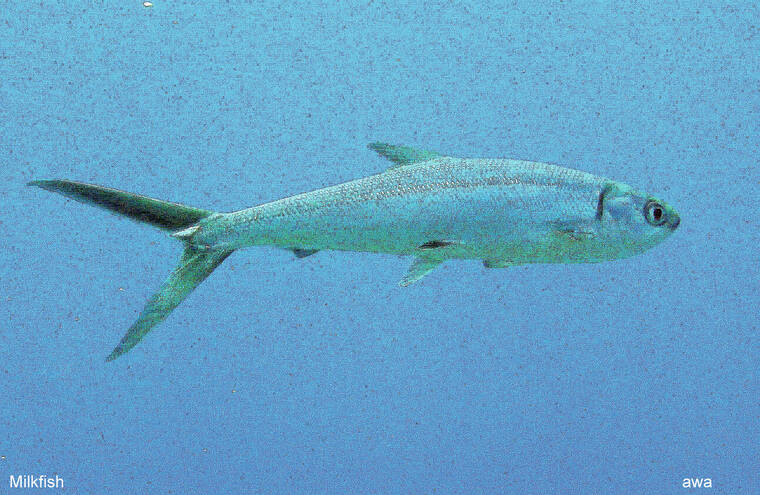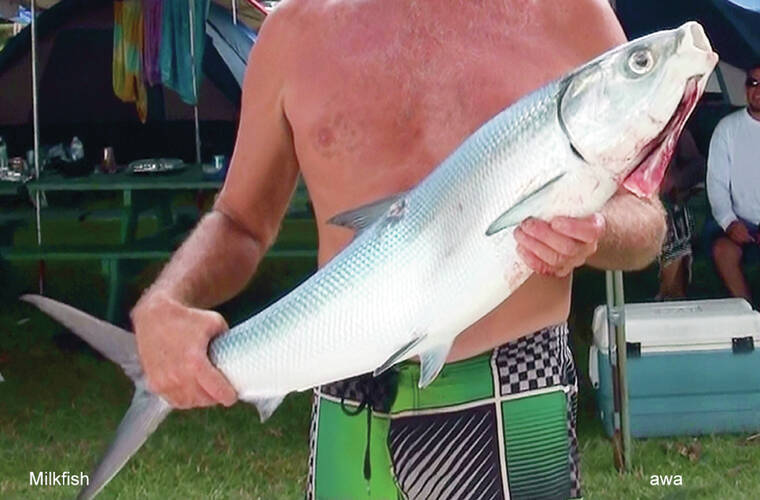“Shark!” That is what I often hear surfers yell when we are surfing out at Hanalei Bay in the spring because they see on the surface a big dorsal fin coming right at them. The milk-fish lives most of its time out at sea where it filter feeds on plankton and shrimp.
They grow to be over six feet long and they have a large dorsal fin that does look like a shark fin. But these fish are harmless and they do not even have any teeth! I saw one surfer totally panic when he was surrounded by six awa at the same time, which were circling him while he sat on his surfboard waiting for a wave. Pretty scary sight when you think about it, but I had a good laugh!
These big fish only come to shore in the spring and early summer to spawn, and also visit a fish-cleaning station. Small fish will eat the parasites that grow on the awa’s scales, and even in its mouth. Kind of like having our car washed once a year. These cleaning stations can be in such shallow water that this six-foot-long fish may rest motionless in three feet deep of water with its dorsal fin sticking straight up into the air. This can scare a group of snorkelers out of the water quite quickly!
Fishermen don’t usually catch the milk-fish with a rod and reel, as they don’t eat the kind of food used for pole fishing, but people spearfishing often get them. Many times I have had a spearfisherman call me up and say “I just speared a big silver fish but I have no idea what it is.”
In old Hawai‘i, awa was a prized fish to eat, and was raised in fishponds. The awa spawn at sea, but the small larvae when they hatch move up coastal rivers into brackish wetlands where the Hawaiian caught them in a net and raised them in their fishponds. Awa are very good to eat, and are raised in brackish water by cultures all around the Pacific Ocean. The name milk-fish comes from a soup made with the fish that looks like a bowl of milk.
Like many fish species the Hawaiians raised or speared, there are different names for different sizes of the same fish. The small milk-fish are called “pua awa,” while the medium-size “awa‘aua” and the adult fish were “awa,” and the super-big adults were “awa kalamoho.” Many ocean fish here in Hawaii lay eggs and the eggs float on currents and may end up a long way from where they were laid. This sometimes causes confusion as to what species is which because an adult awa could lay eggs that drift to another island where they mature, but there may not be any adults near that island. So in some places in Hawai‘i, there are names for a juvenile fish but they may not have a name for the adult because they may have never seen one! This makes it quite difficult to find out the traditional Hawaiian name for certain fish species, as it may be different on different islands. Many estuary-spawning fish in Kaua‘i may have their young drift on currents to Ni‘ihau, where they grow, but they don’t spawn on Ni‘ihau due to the lack of calm estuaries on that rugged island.
You can see awa in action on my underwater educational web at nderwater2web.com in my movie “The World’s Guide To Hawaiian Reef Fish,” and follow my underwater educational Instagram post just under my name.
•••
Terry Lilley is a marine biologist living in Hanalei and co-founder of Reef Guardians Hawai‘i, a nonprofit on a mission to provide education and resources to protect the coral reef. To donate to Reef Guardians Hawaii go to www.reefguardianshawaii.org.






